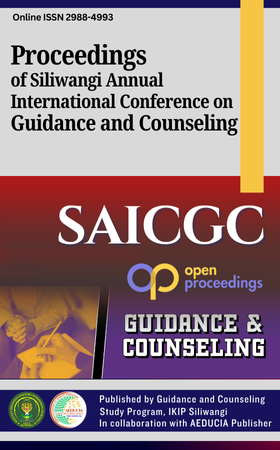Unraveling the Cultural Dynamics of Nonviolence in Schools: A Study of the Development of Nonviolence Pedagogy
DOI:
https://doi.org/10.64420/saicgc.v3i1.338Keywords:
Nonviolence, Development, Nonviolence PedagogyAbstract
Violence in educational settings remains a critical issue that causes psychological trauma, perpetuates intergenerational cycles of aggression, and undermines the role of schools as safe spaces for students. This study aims to explore the cultural dynamics of nonviolence in schools through conceptual analysis, bibliometric review, and a quantitative survey. The adapted Teenage Nonviolence Test (TNT) for Indonesian adolescents was employed, measuring four key dimensions: Physical Nonviolence, Psychological Nonviolence, Satyagraha, and Tapasya. Data were collected from junior high school students from both conventional schools and Islamic boarding schools, analyzed using descriptive-analytic methods, one-way ANOVA, and supported by qualitative insights. The findings indicate that the culture of nonviolence in schools remains underdeveloped and is strongly influenced by protective factors within families and communities. Bibliometric analysis further revealed that nonviolence research over the past decade has been dominated by philosophical, legal, and political perspectives, while counseling and psychology remain underexplored. This study highlights the need for a systemic approach to foster a safe, inclusive educational environment grounded in nonviolent values, positioning nonviolence not only as a strategy to prevent harm but also as a pathway to positive peace and social justice.
References
Ackerman, J.M., Hill, S.E., Murray, D. (2018). RThe behavioral immune system: Current concerns and future directions. Current concerns and future directions. Soc Personal Psychol Compass. 2018; 12:e 12371. https://doi.org/10.1111/spc3.12371 .
Almond, L. (2007). School Violence. Detroit: Greenhaven.
Central Bureau of Statistics , (2023). Ratio of Gross Participation Rate (APK) of Female/Male at the Tertiary Level According to Province , 2021-2023. https://www.bps.go.id/id/statistics-table/2/MTUyNyMy/rasio-angka-partisipasi-kasar--apk--perempuan-laki-di-tingkat-perguruan-tinggi-menurut-provinsi.html. Accessed on June 10, 2024.
Baker, L.A. (2015). The Biology Of Relationships: What Behavioral Genetics Tells Us About Interactions Among Family Members. De Paul Law Rev. Spring;56(3):837-846. PMID: 26702156; PMCID: PMC4685725. National Library of Medicine.
Barbour, S. (2004). How Can School Violence Be Prevented? Detroit: Greenhaven.
Berliner, D., Glass, G., et al. (2014). 12 Myths about American Schooling. New York: Teachers College Press.
Bronfenbrenner, U. (1979). The ecology of human development: Experiments by nature and design. Cambridge, MA: Harvard University Press.
Bronfenbrenner, U., & Morris, P. A. (1998). The ecology of environmental processes. In W. Damon (Series Ed.) & R. M. Lerner (Vol. Ed.), Handbook of child psychology (5th ed., Vol. 1, pp. 993–1028). New York: Wiley.
Cowan, P. A., & Cowan, C. P. (2019). The role of parental relationships in children's well-being: a modest set of proposals for improving the lives of children. Human Development, 62(4), 171–174. https://doi.org/10.1159/000500173 .
Das, V. (2007) Life and Words: Violence and the Descent into the Ordinary, Berkeley and Los Angeles: University of California Press.
Detikedu . (2023). " Ministry of Education, Culture, Research and Technology Demolish Number of Cases of the Three Great Sins in Educational Units " more https://www.detik.com/edu/edutainment/d-7017200/kemendikbudristek-bongkar-jumlah-kasus-tiga-dosa-besar-di-satuan-pendidikan. Accessed on June 10, 2024.
Fiese, B. H., Hooker, K. A., Kotary, L., & Schwagler , J. (1993). Family rituals in the early stages of parenthood. Journal of 3996 Journal of Child and Family Studies (2023) 32:3988–3998 Marriage and Family, 55(3), 633–642. https://doi.org/10.2307/ 353344.
Fiese, B.H., Tomcho, T.J., Douglas, M., Josephs, K., Poltrock, S., & Baker, T. (2002). A review of 50 years of research on naturally occurring family routines and rituals: causes for celebration? Journal of Family Psychology, 16(4), 381–390. https://doi.org/ 10.1037/0893-3200.16.4.381.
Bonisch , A. (1981). Elements of the Modern Concept of Peace. Journal of Peace Research , 18(2), 165-173.
Galtung, J. (1964). An Editorial : Journal of Peace Research. 1(1), 1-4.
Galtung, J. (1969). Violence, peace, and peace research, Journal of Peace Research, 6, 3: 167–91.
Galtung, J. (1990) Cultural violence, Journal of Peace Research, 27, 3: 291–305.
Galtung, J. (1996) Peace by Peaceful Means: Peace and Conflict, Development and Civilization, Thousand Oaks,, CA : Sage.
Greenberg, M.T., Weissberg, R.P., Utne O'Brien, M., Zins, J.E., Fredericks, L., Resnik, H. & Elias, M.J. (2003). Enhancing school-based prevention and youth development through coordinated social, emotional, and academic learning. American Psychologist, 58, 466–474.
Hattie, J. (2009 ).Visible learning. London: Routledge.
Hess, C. (2008). Sites of Violence, Sites of Grace: Christian Nonviolence and the Traumatized Self. Lanham MD: Lexington Books
Hirsch, B.J., Moos, R.H., & Reischl, T.M. (1985). Psychosocial adjustment of adolescent children of a depressed, arthritic, or normal parent. Journal of Abnormal Psychology, 94(2), 154–164. https://doi.org/10.1037/0021-843X.94.2.154 .
Hughes, T. (1857) Tom Brown's School Days: By An Old Boy, Cambridge: Palgrave Macmillan.
Johansen, J. “Nonviolence: More than the Absence of Violence”, in Webel, Charles, and Johan Galtung (ed. ), Handbook of Peace and Conflict Studies, Routledge, London, 2007.
Kompas, (2023). There were 136 cases of violence in schools Throughout 2023, 19 People Died . https://www.kompas.id/baca/humaniora/2023/12/16/terjadi-136-kasus-kekerasan-di-sekolah-sepanjang-2023. Accessed June 08, 2024
Larkin, R.W. (2009) The Columbine Legacy: Rampag
Leeuwen, C. J. van, J. Frijns , A. van Wezel, & F. H. M. van de Ven (2012). City blueprints: 24 indicators to assess the sustainability of the urban water cycle. Water Resources Management 26(8), 2177-2197. Water Resources Management. 26. 2177-2197.
Meece, J. L., & Eccles, J. S. (Eds.). (2010). Handbook of research on schools, schooling and human development. New York: Routledge.
Dornschneider , S., & Henderson, N. (2016). A Computational Model of Cognitive Maps: Analyzing Violent and Nonviolent Activity in Egypt and Germany. The Journal of Conflict Resolution, 60(2), 368–399. http://www.jstor.org/stable/24755915
Mayton, Daniel & Susnjic , Silvia & Palmer, B. & Peters, Danya & Gierth , Richard & Caswell, Rosalie. (2002). The Measurement of Nonviolence: A Review. Peace and Conflict: Journal of Peace Psychology. 8. 343-354. 10.1207/S15327949PAC0804_03.
Kool, V. K., Agrawal, R. (2020). Cognition of Nonviolence. In: Gandhi and the Psychology of Nonviolence, Volume 1. Palgrave Macmillan, Cham. https://doi.org/10.1007/978-3-030-56865-8_8
Kahneman, D., & Tversky, A. (1979). Prospect theory: An analysis of decisions
under risk. Econometrica , 47, 263–291.
Morrell, R., Bhana, D., and Hamlall , V. (2012). Rethinking School Violence Theory, Gender, Contex . Edited by Saltmarsh, S., Robinson, K.H., and Davies, C. Palgrave Macmillan.
Muller, J. M. (20202). Non-Violence in Education. UNESCO:Institut de Recherche sur la Resolution Nonviolente des Conflits ( IRNC).
Oaten, M,. Stevenson, R. J & Case, T. I. (2009). Disgust as a disease-avoidance mechanism. Psychol Bull. 2009 Mar;135(2):303-21. doi : 10.1037/a0014823. PMID: 19254082.
Parks, P. J. (2009). School Violence: A Convenient Research and Learning Toll Including. San Diego: ReferencePoint Press.
Robert, R. (2015). School and Community Influences on Human Development.
Roeser, R. W., & Eccles, J. S., (2014). Schooling and the mental health of children and adolescents in the United States (pp. 163–184). In M. Lewis & K. D. Rudolph (Eds.), Handbook of developmental psychopathology (3rd ed.). New York: Springer
Saferspaces . (2024). Understanding Risks for Violence Victimization and Perpetration Risks and Protective Factors: Introduction to the Ecological Model. https://www.saferspaces.org.za/section/risks-and-protective-factors-introduction-to-the-ecological-model. Accessed 09 June 2024
Schaller, M., & Park, J. H. (2011). The Behavioral Immune System (and Why It Matters). Current Directions in Psychological Science, 20(2), 99-103. https://doi.org/10.1177/0963721411402596 .
Spagnola, M., & Fiese, B. H. (2007). Family routines and rituals: a context for development in the lives of young children. Infants and Young Children, 20(4), 284–299. https://doi.org/10.1097/01. IYC.0000290352.32170.5a.
Thomas, B. Jr. (2004). Genetic Influence on Human Psychological TraitsA Survey. Current Directions in Psychological Science - Curr Direction Psychol SCI. 13. 148-151. 10.1111/j.0963-7214.2004. 00295.x.
Van As, NMC, & Janssens, JMAM (2002). Relationships between child behavior problems and family functioning: a literature review. International Journal of Child & Family Welfare, 5(1–2), 40–51.
Wahid. A. Islam, Nonviolence, and National Transformation. Edited by Glenn D. Paige Chaiwat Satha-Anand (Qader Muheideen ) Sarah Gilliatt. Center for Global Nonviolence 2001.
Weil, S. (1995). I'exigence de non-violence, Desclee de Brouwer, [ Sirnone Weil, the need for non-violence): Prix Anne de Jaeger.
World Health Organization. The VPA Approach. https://www.who.int/groups/violence-prevention alliance/approach #:~ :text=Definition%20and%20typology%20of%20violence&text=This%20typology%20distinguishes%20four%20modes,and%20psychological%20attack% 3B%20and%20deprivation. Accessed 09 June 2024.
Sharp, G. (1973). The politics of nonviolent action (part 1): Power and struggle (Vol. 1). Boston: Porter Sargent.
Akers, R. (1990). Rational choice, deterrence, and social learning theory in
criminology. Journal of Criminal Law and Criminology, 81(3): 653–676.
King, M. E. (2002). Mahatma Gandhi and Martin Luther King Jr: The power of nonviolent action (2nd ed.). New Delhi: ICCR/Mehta Publishers.
Standish, K. Devere, H. Suazo, A. Rafferty, R. (2022) The Palgrave Handbook of Positive Peace. ISBN 978-981-16-0969-5 (eBook): Palgrave Macmillan
Bhana, D. (2006) 'Doing power': Confronting violent masculinities in primary
schools. In F. Leach and C. Mitchell (Eds.) Combating Gender Violence In and Around Schools (pp. 171–179). London: Routledge Falmer
Rosenberg, M. B. (2003). Nonviolent Communication: A Language of Life. PuddleDancer Press.
Germer, C.K., Siegel, R.D., & Fulton, P.R. (Eds.). (2013). Mindfulness and Psychotherapy. Guilford Press.
Davidson, R. J., & Begley, S. (2012). The Emotional Life of Your Brain: How Its Unique Patterns Affect the Way You Think, Feel, and Live--and How You Can Change Them. Hudson Street Press.
Rayle, J. (2010). Peace Education: A Systemic Freamwork . Fitz-Gibbon, A. (ed). Positive Peace Reflections on Peace Education, Nonviolence, and Social Change. © Editions Rodopi BV, Amsterdam - New York, NY 2010
Selwyn, N. (2012). Ten suggestions for improving academic research in education and technology. Learning, Media and Technology, 37(3), 213–219. https://doi.org/10.1080/174
Downloads
Published
How to Cite
Issue
Section
License
Copyright (c) 2025 Ardian Renata Manuardi

This work is licensed under a Creative Commons Attribution-ShareAlike 4.0 International License.
Authors who publish with this journal agree to the following terms: (1) Authors retain copyright and grant the journal right of first publication with the work simultaneously licensed under a Creative Commons Attribution-ShareAlike 4.0 International. that allows others to share the work with an acknowledgement of the work's authorship and initial publication in this journal; (2) Authors are able to enter into separate, additional contractual arrangements for the non-exclusive distribution of the journal's published version of the work (e.g., post it to an institutional repository or publish it in a book), with an acknowledgement of its initial publication in this journal; (3) Authors are permitted and encouraged to post their work online (e.g., in institutional repositories or on their website) prior to and during the submission process, as it can lead to productive exchanges, as well as earlier and greater citation of published work.




















